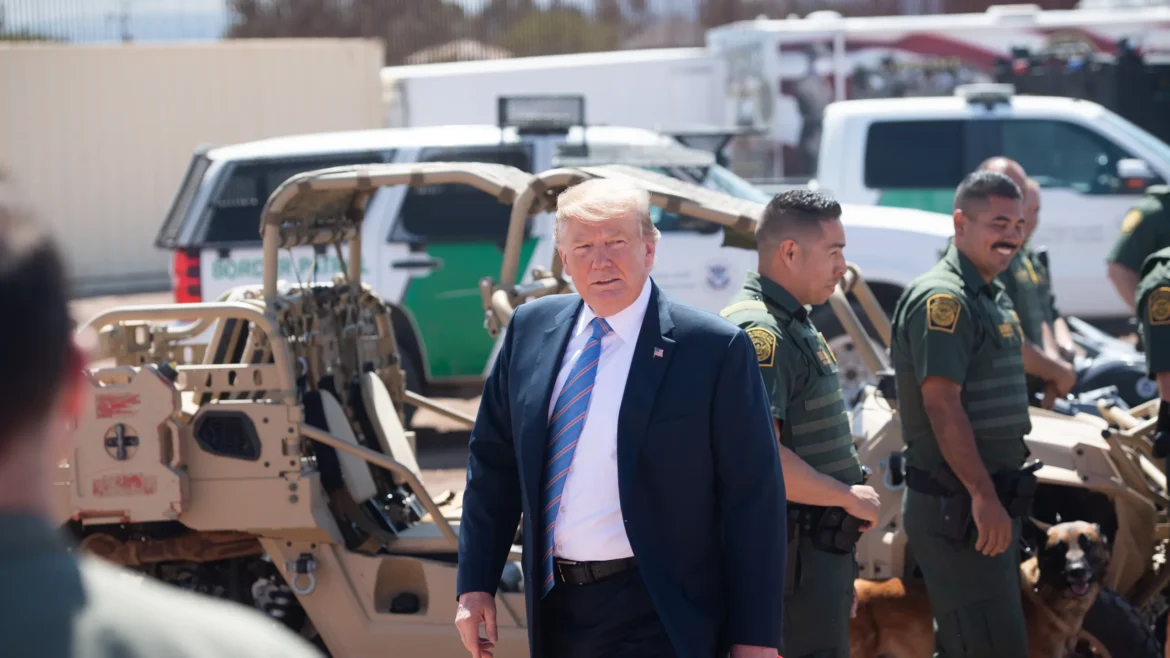In a dramatic move that could reshape U.S. border security policy, former President Donald Trump is reportedly considering the deployment of 10,000 troops to the U.S.-Mexico border. The information comes from an internal memo, signaling Trump’s plans to make border security a central pillar of his political agenda as he eyes a potential return to the presidency.
The memo outlines the former president’s concerns over what he perceives as a worsening crisis at the southern border. According to Trump, the current immigration policies have allowed for unchecked illegal crossings and have emboldened drug cartels, creating what he describes as a “national security emergency.” The deployment of troops, as proposed in the memo, would be the largest military presence at the border in modern U.S. history.
The proposed deployment would see the troops performing various roles, including surveillance, logistical support, and reinforcing physical barriers along the border. Trump has consistently advocated for strong measures to curb illegal immigration, often framing it as essential to safeguarding American jobs, communities, and national security.
The memo emphasizes Trump’s belief that the presence of a significant military force would serve as both a deterrent to illegal crossings and a tool to disrupt drug trafficking operations. The troops, under this plan, would work alongside border agents and provide critical support to counter the surge in unauthorized entries.
“Unprecedented times call for unprecedented measures,” the memo states. “A robust military presence is necessary to protect our borders and restore order.”
The proposal has sparked widespread reactions across the political spectrum. Trump’s supporters have hailed the move as a decisive step toward regaining control of the border. They argue that stricter enforcement is long overdue and believe the deployment would address longstanding issues exacerbated by surges in migrant arrivals.
Critics, however, view the proposal as a dangerous overreach. Immigration advocates warn that militarizing the border could lead to human rights violations, particularly for migrants fleeing violence and persecution. Others have questioned the cost and effectiveness of using the military to handle what they see as a humanitarian challenge rather than a military threat.
“This is not the solution to our border problems,” said an immigration rights group spokesperson. “We need comprehensive immigration reform, not the militarization of our southern border.”
Deploying federal troops to the border is a controversial move that raises legal and ethical questions. The Posse Comitatus Act generally prohibits the use of federal military personnel for domestic law enforcement, though exceptions can be made in cases of national emergencies. Trump’s proposal argues that the current state of the border constitutes such an emergency, thereby justifying the deployment.
The U.S. military has previously been deployed to the border in a limited capacity, mostly under Operation Guardian Support during Trump’s presidency. However, the scale of this proposed deployment—10,000 troops—would be unprecedented.
The memo signals Trump’s intent to make border security a cornerstone of his political platform, should he return to power. During his presidency, Trump implemented several hardline immigration policies, including the construction of sections of the border wall and the controversial family separation policy.
This latest proposal suggests Trump is doubling down on his tough-on-immigration stance, likely aiming to rally his base ahead of a potential 2024 presidential bid.
However, critics argue that such measures do little to address the root causes of migration, such as poverty, violence, and political instability in Central and South America. They also warn that focusing solely on enforcement risks ignoring the economic and humanitarian benefits that immigration brings to the U.S.
The U.S.-Mexico border has been a flashpoint in American politics for decades, with successive administrations grappling with how best to address the challenges of illegal immigration, asylum processing, and drug trafficking.
Recent years have seen a surge in migrants arriving at the border, driven by economic hardship, political instability, and natural disasters in their home countries. The Biden administration has faced criticism from both sides of the aisle over its handling of the border, with Republicans calling for stricter enforcement and Democrats urging more humane policies.
Trump’s proposal comes at a time when border security is already under intense scrutiny. Customs and Border Protection (CBP) reported record numbers of encounters at the border in 2023, further fueling the debate over how to manage migration effectively.
While the memo’s proposals may energize Trump’s supporters, they also pose risks. Critics argue that deploying troops to the border could alienate moderate voters and escalate tensions in already strained border communities.
At the same time, the proposal underscores Trump’s strategy of portraying himself as a strong leader on issues of national security and immigration. His framing of the border crisis as a national emergency is likely to resonate with his base, even as it sparks backlash from opponents.
It remains unclear whether the proposal will advance beyond the discussion stage. However, the memo’s release has reignited debates over how best to address the challenges at the U.S.-Mexico border.
As the immigration debate continues to dominate headlines, Trump’s proposal is a reminder of the deeply polarized views on how to manage America’s borders. Whether this latest idea gains traction or fades into political posturing, one thing is clear: the border will remain a key battleground in U.S. politics for the foreseeable future.


